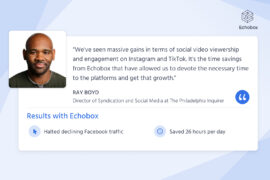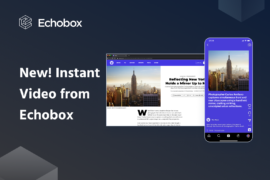Newsletters are experiencing something of a boom. This probably isn’t news to you. For the better part of a decade now, publishers have figured digital subscriptions to be a far more reliable source of revenue than advertising, as Facebook and Google continue to dominate the market. And for many publishers, newsletters are an essential component of a digital subscription strategy. In fact, 70% of media leaders plan to focus their efforts on email newsletters this year, according to the Reuters Institute for the Study of Journalism’s 2022 Trends and Predictions report.
Much was made of then New York Times CEO Mark Thompson’s 2016 announcement that the paper was aiming to amass 10 million digital subscribers by 2025, a huge increase for a company that had, at that time, around 1.6 million. But by the end of 2021, The Times was within touching distance of that figure, and years ahead of schedule.
For The Times, newsletters have been a driving force behind this increase. Regularly offering readers quality content, tailored to their interests and straight to their inbox, The Times has a roster of around 50 newsletters with a weekly readership of approximately 15 million. But what makes newsletters such an attractive proposition? In August, The New York Times Company’s president and CEO Meredith Kopit Levien summed it up:
Given the opportunity we see — an addressable market of at least 100 million people who are expected to pay for English-language journalism and a unique moment in which daily habits are up for grabs — we are continuing to invest in both the value of our individual products and the broader bundle.
Habit formation is the holy grail for publishers, many of whom are looking at strategies to establish their content as an indispensable part of daily life for their audience. Whether it’s the morning commute, the lunch break or the after-dinner time on the sofa, the right strategy can convert an idle moment into a regular daily routine and turn the curious into consistent consumers.
So what makes for a habit-forming newsletter? How can you make sure it’s “sticky” enough to become an integral part of your readers’ routines? Here are 5 dos and don’ts to help you craft newsletters that your readers won’t want to miss.
Do make sure that your content is personalized
Between 2016 and 2017, the Reynolds Journalism Institute conducted a study testing the hypothesis that personalized email newsletters would outperform those curated by an editor. To test this, researchers created an algorithm that selected articles based on the extent to which they matched the reader’s stated preferences. A second group received a newsletter produced solely with input from a human editor. The results, published in early 2017, were conclusive: the algorithmically personalized newsletter comprehensively outperformed its editor-curated rival, with an open rate of 75% as opposed to 38% and a click rate of 14% as opposed to 5%.
Ensuring that your content is relevant to as specific a section of your audience as possible, therefore, can produce significant results. In 2019, News UK launched James, a “digital butler” that used machine learning to analyze subscribers’ reading patterns and serve up content more suited to their interests. The group presented with content chosen by James demonstrated a 49% lower churn rate than a control group without James’ curation. In short, gaining the deepest possible understanding of your readers and leveraging that knowledge to create targeted, relevant content can produce incredible results.
Don’t assume that conversion means retention
Recent analysis suggests that as many as 39% of news subscribers globally haven’t visited the website of the publication to which they subscribe in the past month. For well over a third of readers, the act of subscribing alone is not enough to guarantee sustained and regular readership, and unsurprisingly, these readers are by far the most likely to churn, according to the study.
A successfully targeted newsletter can be an incredibly potent tool to ensure the “stickiness” of subscriptions, by giving your readers what they want. The Economist, for example, determined that one of the biggest reasons for subscriber churn was being overwhelmed by the sheer volume of content. To combat this, The Economist redesigned its newsletters with audience experience top of mind, looking for ways in which they could refine their product and tie it in with the print edition, as well as better showcasing the range of The Economist’s articles. These changes produced a substantial increase in newsletter referral of 41%.
Do stay topical
Newsletters can be a wonderfully malleable product. With little additional cost, newsletters can be produced to capitalize on topical events that have caught the public’s imagination. Sports are an obvious example, with major competitions providing a ready-made audience hungry for information, but these topical newsletters leave much more scope for imagination. Newsday, for example, capitalized on summer holiday traffic with a ten-week newsletter, Points East, discussing all things Hamptons.
Of course, one topic in particular has dominated the news in recent years. During the global COVID pandemic, the coronavirus newsletter became one of the most pronounced media trends, with Gannett, The Washington Post, Time Magazine and others quickly building large subscriber bases to their pop-up newsletters. Despite their ubiquity, they provided a case in point about the effectiveness of newsletters to deliver accurate, insightful and targeted information to a broad public.
With the additional flexibility that email newsletters afford, publishers can target even more specific groups and attract readers who may not normally be exposed to their content, whilst also starting the process of habit creation. And the process of building and managing newsletters no longer needs to be time consuming. Automated newsletter solutions such as Echobox Newsletters mean that bespoke, highly targeted emails can be rapidly and automatically put together and scaled as and when the opportunity arises.
Don’t think that there’s one best time to send
Finding the perfect time to send newsletters is easier said than done. Developing habit relies on a sense of expectation, meaning that it’s a good idea for your newsletter to appear at roughly the same time each time. But the optimal timing will vary depending on content and from person to person. There is lots of noise regarding the best time to post, but unfortunately, as we noted in this analysis and in this follow-up study, much of it is misguided. In reality, the best time to post depends on any number of factors that require detailed analysis, and moreover these factors can change from day to day, even hour to hour. The only way to figure out the best time to post is to conduct the kind of systematic, large-scale testing that only computers can carry out.
A simple alternative is to use a solution like Echobox Newsletters, which uses the latest advances in AI and machine learning to automatically determine the best time(s) to send your newsletter editions, maximizing your click and open rates as a result.
Do experiment with design and layout
Newsletters can generate a wealth of insights that can be used to refine your offering. Through carefully designed experimentation, each facet of your newsletter can be tweaked to increase all manner of key metrics. Typically, design tips are relatively broad recommendations that repackage common sense as sage advice, and this is for a simple reason: the best way to design your newsletter will vary depending on the preferences of your readers. So whilst having a clean design language and easily legible text is a good idea, it really doesn’t begin to exhaust the possibilities.
This said, experimentation of this kind can be difficult and time-consuming to conduct. Investing in an automated solution that can intelligently and automatically test the effectiveness of your design to a granular level can therefore be a cost-effective solution to achieve amazing results with newsletters.
Email newsletters offer publishers an immense opportunity to attract new readers, build loyalty with audiences, and avoid churn from paying subscribers. Whether you’re looking to augment an existing newsletter or planning to launch a new one, implementing the above recommendations will help you deliver the best newsletter possible to keep your subscribers engaged and start habits that stick.




